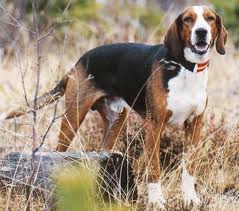The Finnish Hound is the most popular dog breed in Finland, its country of origin, where it was developed in the 1800s for hunting foxes and hares in the harsh winter conditions of Finland. The breed was created by crossbreeding German, Swiss, Swedish, French and Russian hounds.

In addition to its keen sense of smell, this breed is suitable for working on rough terrain and in deep snow because, despite its short-haired coat, it is a hardy breed, which is highly adaptable to all climates. Its popularity in Finland and Sweden alike is due not only to its highly valued hunting abilities, but also to its affectionate, loving and extremely intelligent nature. Finland's native breed is less commonly known in other countries. This medium-sized breed loves to be outdoors to either work or exercise, thus it is not suited to live in apartments, being very active and energetic. Daily exercise of at least one hour, suchlike running, works miracles on its overall health; and so do interactive and constructive activities with its family.
The agile and outgoing Finnish Hound is the most appreciated hunting breed, because, unlike other hound breeds, it does not kill nor retrieve the game. Upon tracking a prey, it will make use of its resonant voice to alert its owner. They enjoy working for its owner, but when not at work, they display a quiet, gentle and perfectly balanced temperament, especially around children, with whom they form a special bond. They are also never aggressive with people and enjoy socializing with other dogs and, if early and properly trained, they can even accept cats, but not other small animals, as they see them as prey. This dog's natural tracking and hunting instincts are strongly embedded in its mind.
This medium-sized breed is, by nature, quite independent and the owner needs to be assertive, yet calm in letting it know who the leader of the pack is, so as to maintain a healthy human/dog relationship and to prevent this dog from getting dominant. Obedience training can be somewhat tricky, because the dog is quite stubborn, and proper training requires patience, calm and firmness. Communication is also important for this even-tempered and gentle breed.
Its general appearance is remarkable and very appealing, given the compact and muscular body and short, dense and shiny, tricolor patterned coat, with tan, saddle-like black and white markings on the head, feet, chest and tail tip. Grooming is easy; the coat only requires occasional brushing, no bathing, and it sheds moderately.
This hound's average height is 20 to 24 inches and its average weight is 44 to 55 pounds. In terms of health issues, it is predisposed to an inherited disorder called cerebellar ataxia, due to a specific gene (SEL-1L) mutation, leading to lack of coordination of balance, gait and eye movements. Hopefully, a test will be developed to screen for these mutant cells. Except for this unfortunate genetic disease, this breed is very sturdy. Its adoptive family needs to respect its daily exercise requirements and to provide an appropriate environment for it - for instance a large fenced backyard where it can run freely. When taken for walks, it should be leashed to prevent possible road accidents.
By adopting the versatile, gentle, playful and friendly Finnish Hound, you can have an ideal family companion and an excellent instinctive tracker and scent hound, very resilient to extreme weather conditions.




